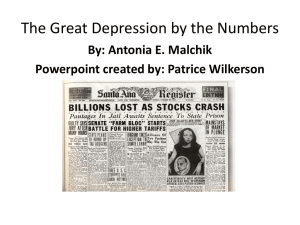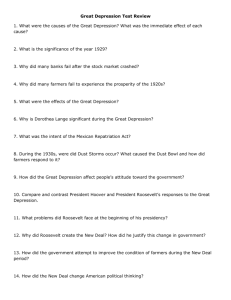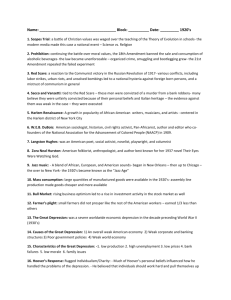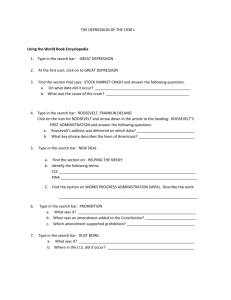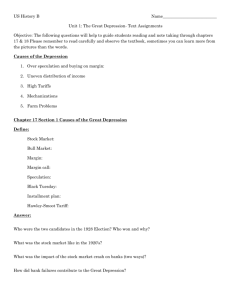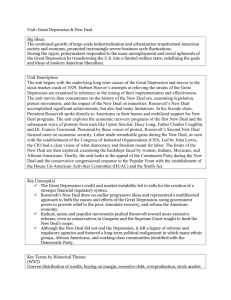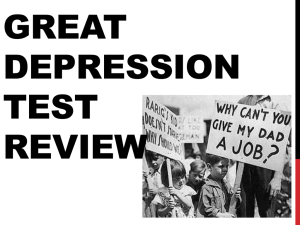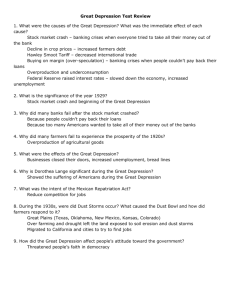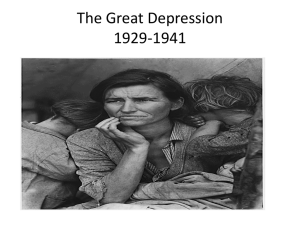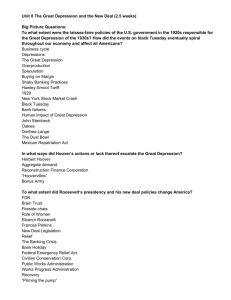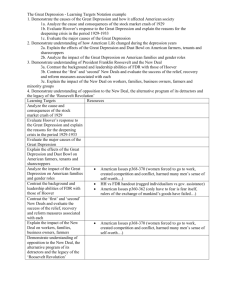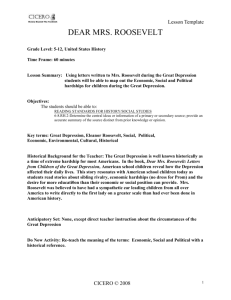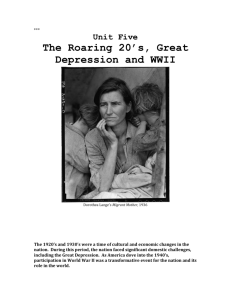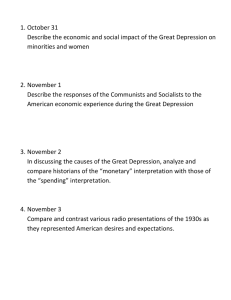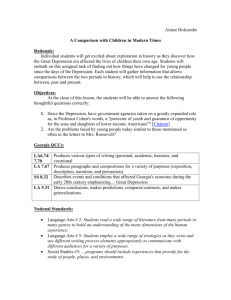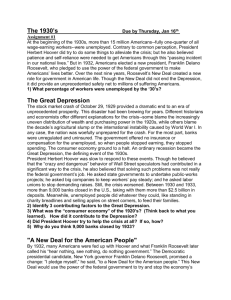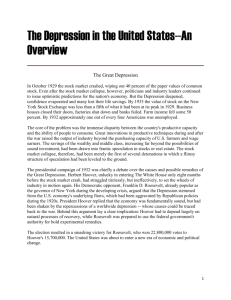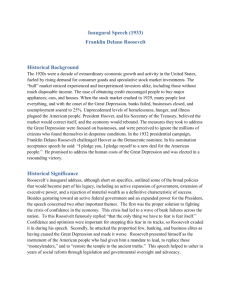the great depression
advertisement
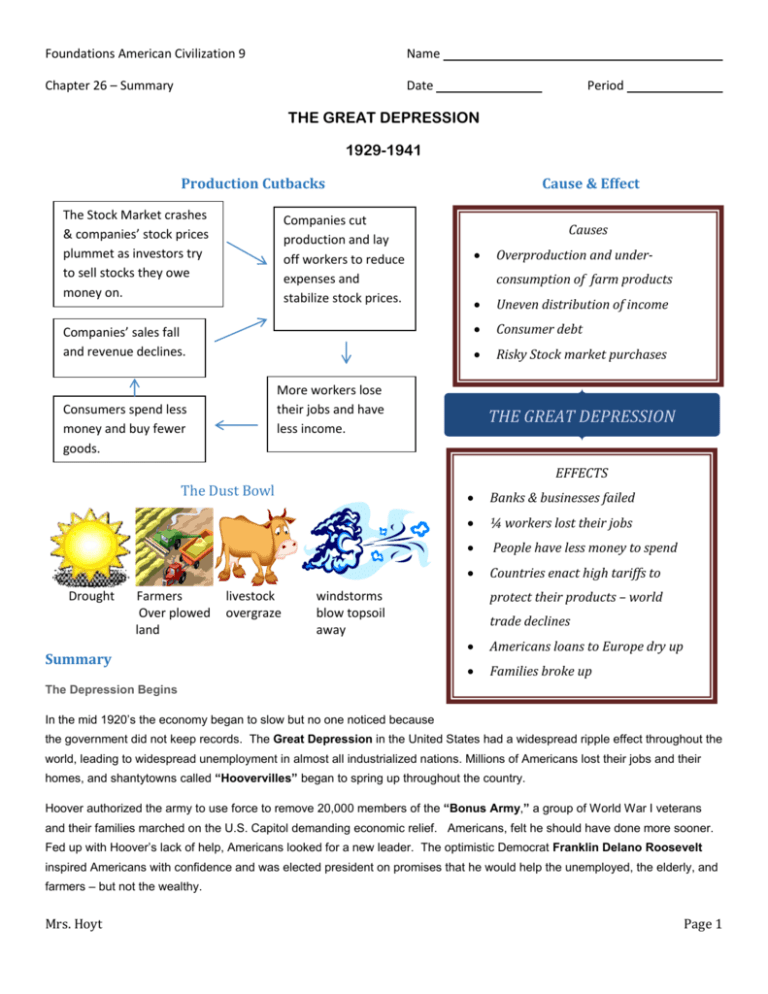
Foundations American Civilization 9 Name Chapter 26 – Summary Date Period THE GREAT DEPRESSION 1929-1941 Production Cutbacks The Stock Market crashes & companies’ stock prices plummet as investors try to sell stocks they owe money on. Cause & Effect Companies cut production and lay off workers to reduce expenses and stabilize stock prices. Causes consumption of farm products Companies’ sales fall and revenue declines. More workers lose their jobs and have less income. Consumers spend less money and buy fewer goods. Overproduction and under- Uneven distribution of income Consumer debt Risky Stock market purchases THE GREAT DEPRESSION EFFECTS The Dust Bowl Drought Farmers Over plowed land livestock overgraze windstorms blow topsoil away Summary Banks & businesses failed ¼ workers lost their jobs People have less money to spend Countries enact high tariffs to protect their products – world trade declines Americans loans to Europe dry up Families broke up The Depression Begins In the mid 1920’s the economy began to slow but no one noticed because the government did not keep records. The Great Depression in the United States had a widespread ripple effect throughout the world, leading to widespread unemployment in almost all industrialized nations. Millions of Americans lost their jobs and their homes, and shantytowns called “Hoovervilles” began to spring up throughout the country. Hoover authorized the army to use force to remove 20,000 members of the “Bonus Army,” a group of World War I veterans and their families marched on the U.S. Capitol demanding economic relief. Americans, felt he should have done more sooner. Fed up with Hoover’s lack of help, Americans looked for a new leader. The optimistic Democrat Franklin Delano Roosevelt inspired Americans with confidence and was elected president on promises that he would help the unemployed, the elderly, and farmers – but not the wealthy. Mrs. Hoyt Page 1 Roosevelt rallied the panicked Democratic majority in Congress and pushed for the passage of a bundle of sweeping laws known collectively as the New Deal. The period of time when these laws, designed to fight the depression, were passed was known as the Hundred Days. New Deal Legislation still in existence New Deal Program Effects Federal Deposit Insurance Guaranteed (Insured) bank Corporation (FDIC) deposits National Labor Relations Protected workers right to join Act (NLRA) unions – guaranteed the right to collective bargaining under the Wagner Act Securities & Exchange Regulated the stock market and Commission (SEC) restored investor confidence Fair Labor Standards Act Established a minimum wage, (FLSA) guaranteed time-and-a-half for overtime in certain jobs and prohibited most employment of minors Tennessee Valley Authority Built dams and hydroelectric (TVA) plants to control flooding, generate Effects of the New Deal Immediate Effects • Banking System is stabilized • Federal Payments help farmers • Work-relief programs provide jobs • Social Security provides safety net • New Deal provides HOPE to people Long-Term Effects • Power of Presidency increases • Government takes active role in economy • New Deal coalition is a powerful political force • Wagner Act protects workers and raises the standard of living • Minoroities and women gain positions in government power, and attract industry to the South Social Security Act (SSA) Provided pensions for the elderly, COURT PACKING SCHEME the unemployed, dependent children and people with disabilities. Federal Housing Insured loans made by banks and Administration (FHA) other private lenders for home building and home buying The End of the New Deal As the Great Depression entered its sixth year, Roosevelt faced an increasing amount of opposition to his New Deal. The Supreme Court ruled several New Deal Programs were unconstitutional. Roosevelt asked Congress to allow him to add six new justices – by increasing the number of justices – FDR would have “stacked the deck” in favor of his programs. It would not be until the United States entered World War II in December 1941 that industry would recover and the economy would truly turn around. Mrs. Hoyt Page 2 Supporters & Critics CRITICS Supporters (Wealthy, Business Owners, & Conservatives, Huey Long) (Labor Union Leaders, poor, unemployed, elderly) - Increased power of government - Threatens individual freedoms - Saved the Nation’s Democratic System - Ended the banking crisis, protected farmers, and - Plays too large a role in economics employed millions - Spending more than brings in – Deficit spending & national debt Government has a responsibility to help citizens and necessary for national survival - Did not achieve its goal of ending the depression All faced extra prejudice and struggled for equal rights during these hard times – employers gave preferences to white men when hiring for jobs. African Americans Native Americans Mexican Americans Women Asian Americans Common Themes = hard times People escaped hard times by watching movies like Snow White 7 the Seven Dwarfs and The Wizard of Oz. Eleanor Roosevelt used her position to speak out for Equal Rights for women Mrs. Hoyt Page 3
